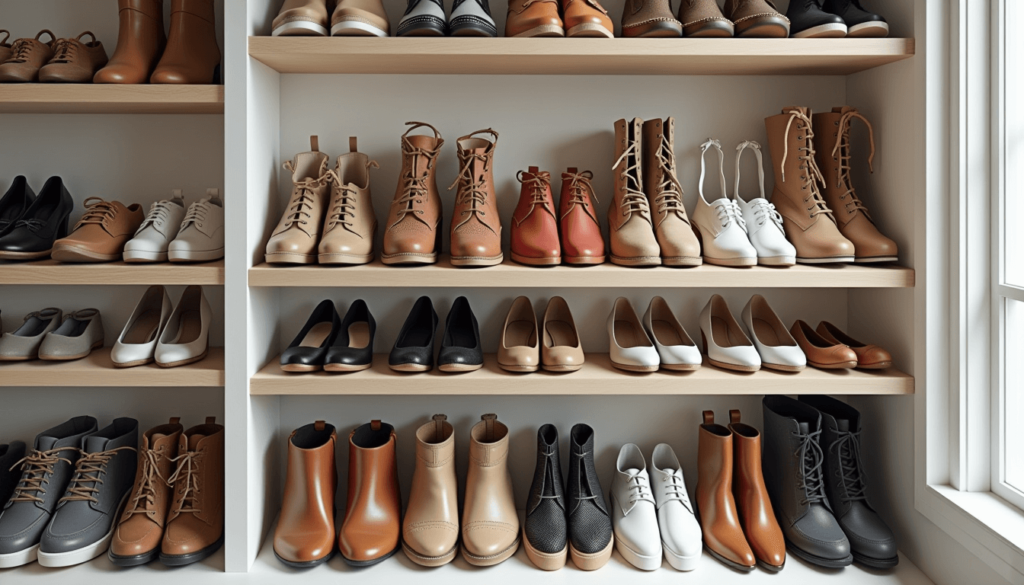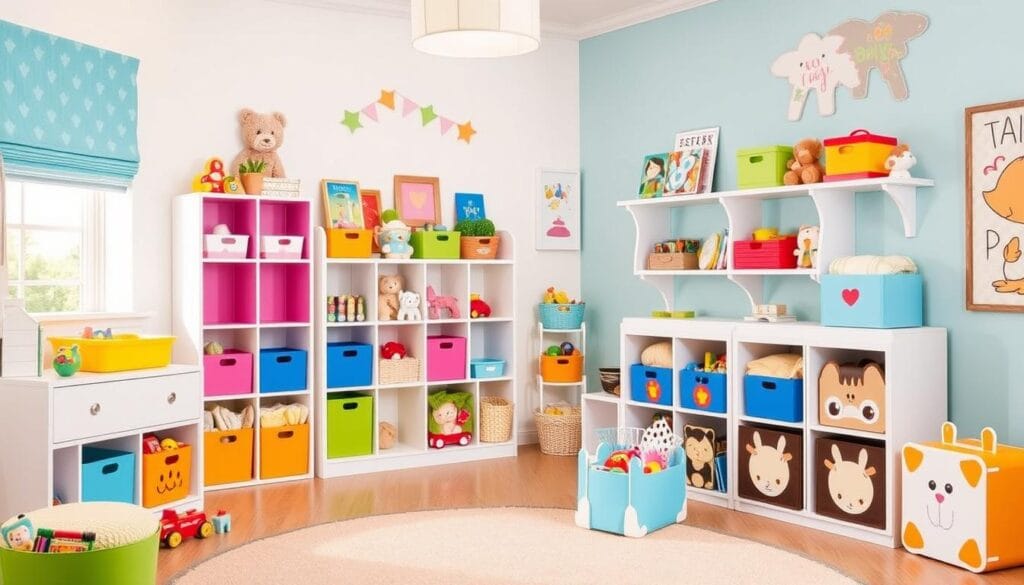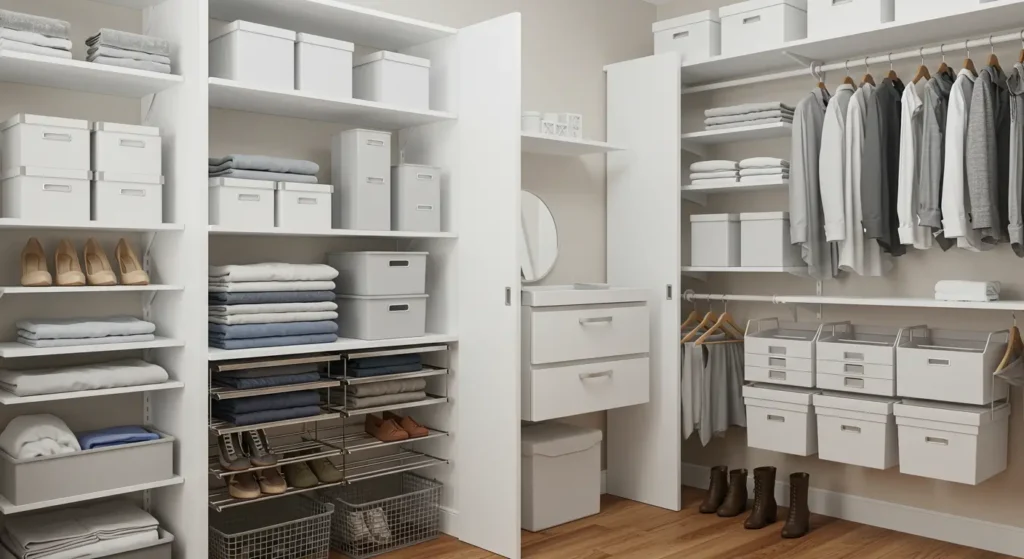How to Organize Shoes? Figuring out how to organize shoes can be daunting—especially with a growing collection. Without a clear system, footwear quickly becomes cluttered and hard to manage. But with a few smart strategies and a bit of planning, you can turn chaos into a streamlined, stylish setup.
Whether you’re working with limited space or a spacious walk-in, this guide will show you how to maximize storage, protect your shoes, and create a visually appealing system that fits seamlessly into your home and lifestyle.
Table of Contents
Whether you own a handful of go-to pairs or a full lineup of shoes for every occasion, the secret to effective shoe organization is tailoring your system to fit your lifestyle, space, and habits.
From compact closets to spacious entryways, the right mix of storage solutions—like stackable bins, clear boxes, or vertical racks—can turn clutter into coordination. This guide breaks down practical, space-savvy strategies to help you keep your shoe collection organized, accessible, and in top condition.
1. Declutter Your Collection: The Essential First Step How to Organize Shoes
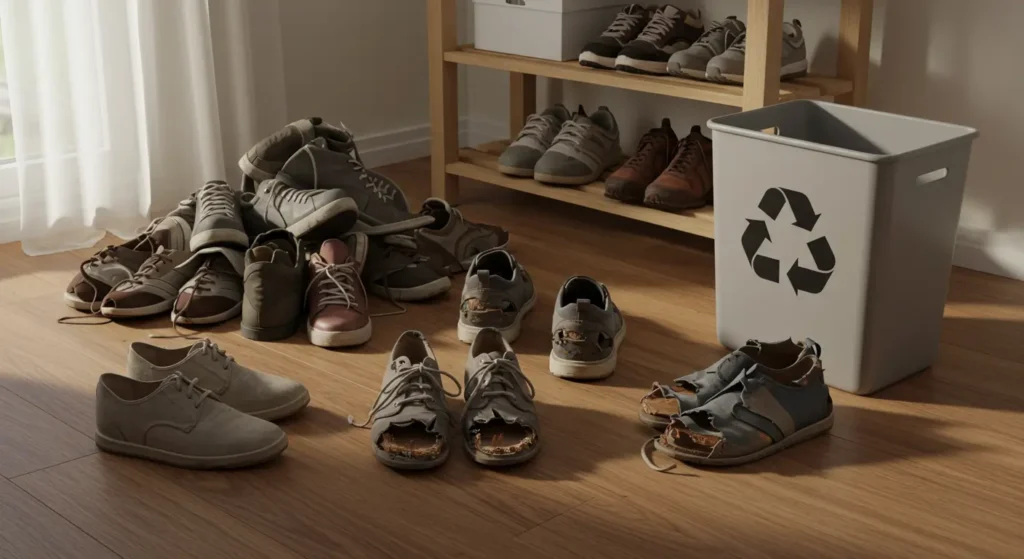
Start with Decluttering: The First Step to Organizing Your Shoe Collection
Before you dive into organizing your shoe storage, take time to declutter. A streamlined collection makes it easier to create an efficient and visually pleasing shoe organization system.
Toss or Recycle Damaged Shoes
Check each pair for damage—cracked soles, torn fabric, or broken heels. If a pair is beyond repair, dispose of it responsibly through recycling programs or designated drop-off locations.
Donate What You Don’t Wear
Haven’t worn a pair in over a year? If they no longer fit your lifestyle or style preferences, set them aside for donation. Gently used shoes can go to local charities or shelters that need them.
Why Decluttering Matters
This step helps reduce clutter and ensures you’re only storing shoes you love and actually wear. It creates space, improves accessibility, and lays the groundwork for a practical and attractive shoe storage solution.
2. Categorize by Type: Creating a Functional System
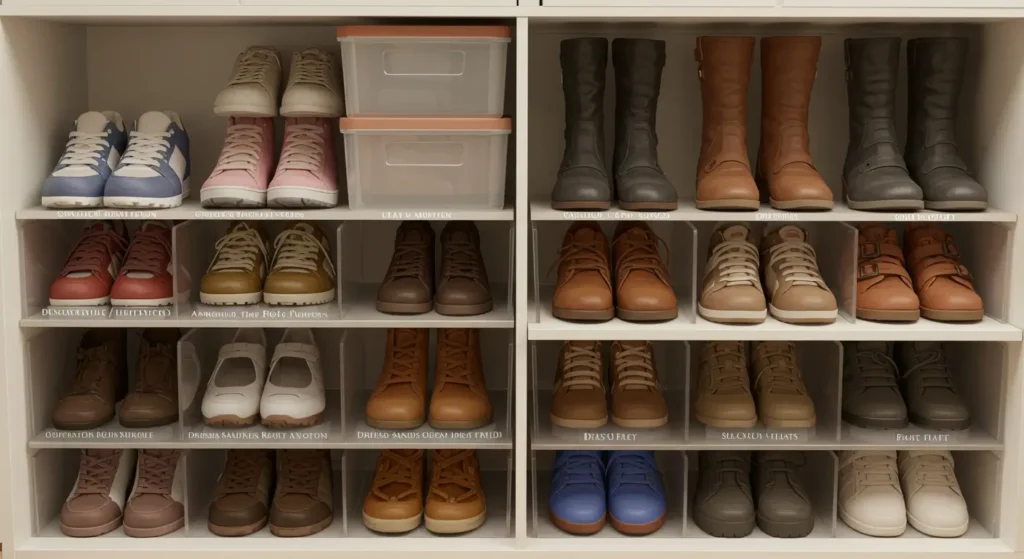
Organize Shoes by Type and Season for Maximum Efficiency
Smart shoe organization starts with sorting by style and season. Grouping shoes this way not only saves time but keeps your space clutter-free and visually organized.
Categorize by Style
Divide your collection into categories like sneakers, heels, boots, sandals, and flats. For example:
- Sneakers: Separate athletic pairs from casual styles.
- Heels: Sort by heel height or purpose—work, parties, or casual.
- Boots: Group ankle, knee-high, and winter boots.
- Flats & Sandals: Organize by function—everyday, dressy, or beachwear.
This structure streamlines your daily routine and keeps every pair easily accessible.
Seasonal Rotation
Keep seasonal shoes front and center. Store winter boots during warmer months and swap in sandals, espadrilles, or light sneakers for summer. Use labeled bins or under-bed organizers for off-season footwear to save space and stay organized.
3. Utilize Vertical Space: Smart Storage Solutions
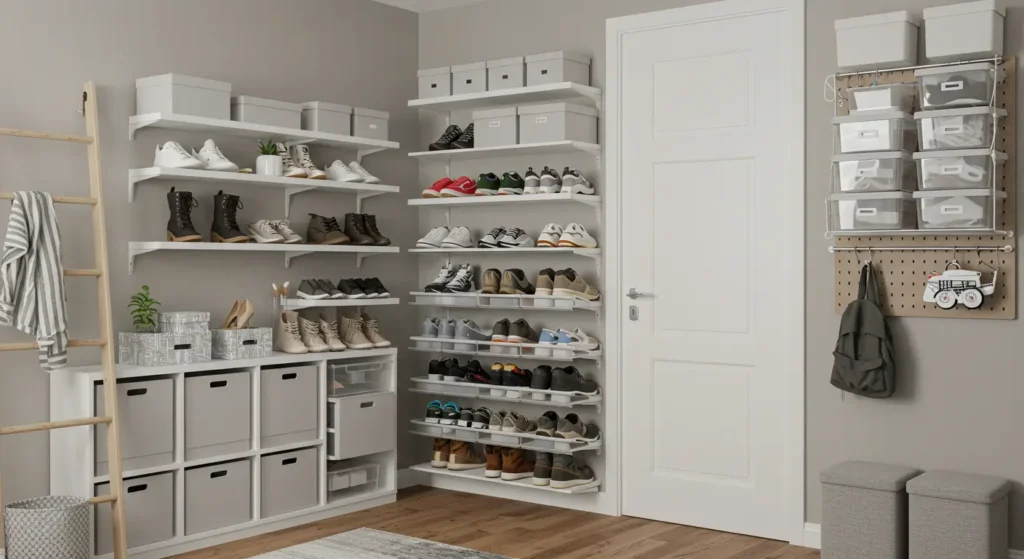
Maximize Shoe Storage by Using Vertical Space Smartly
Making use of vertical space is one of the smartest shoe storage hacks—especially for small spaces. By going upward instead of outward, you’ll save floor space while keeping your shoe collection organized, accessible, and stylish.
Tiered and Floating Shelves
Tiered shelving units are ideal for organizing shoes by height and type. Adjustable tiers accommodate everything from boots to sandals, while floating shelves double as functional decor. Mount them above closets or in tight corners to display lighter pairs like flats or sneakers.
Over-the-Door & Wall Racks
For compact vertical shoe storage, over-the-door organizers and wall-mounted racks are game-changers. They’re great for small apartments and entryways, storing everything from flip-flops to casual sneakers without cluttering your floors.
Stackables & DIY Solutions
Transparent stackable bins help protect and organize shoes while maintaining visibility. Or get creative with vertical ladders and pegboards—perfect for building a custom shoe wall that’s both practical and eye-catching.
Storage Tip: Keep everyday shoes on lower shelves for quick access and reserve top spots for seasonal or special-occasion footwear.
4. Invest in Clear Storage Solutions: Visibility and Protection
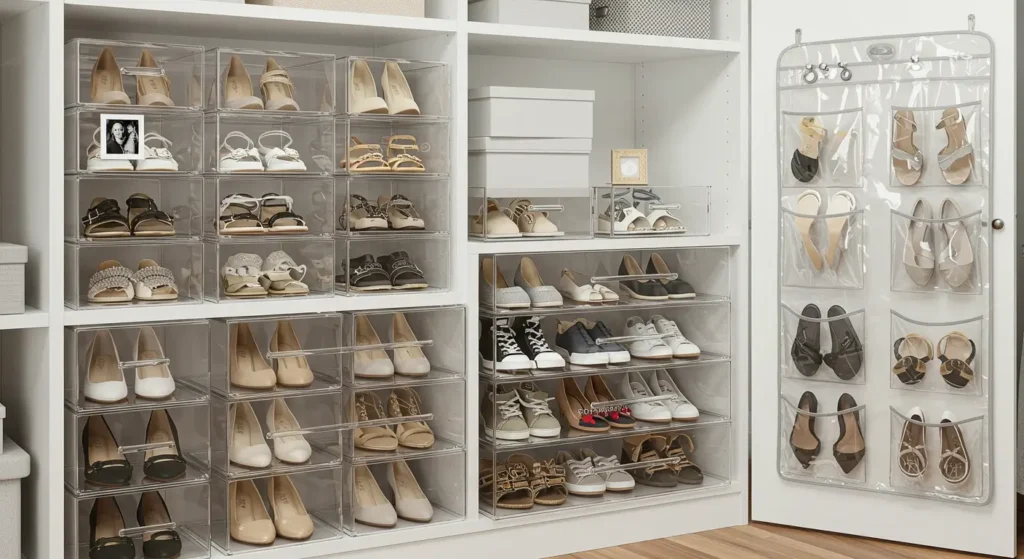
Streamline Shoe Organization with Clear Storage Solutions
Clear storage solutions offer a sleek and efficient way to organize your shoe collection while keeping every pair visible and within reach. With their blend of practicality and visual appeal, these containers help maintain a clutter-free, stylish space.
Why Clear Storage Works
Transparent shoe boxes and organizers let you quickly spot the pair you need without digging through stacks. They also protect shoes from dust, moisture, and wear—preserving quality over time. Plus, their uniform look enhances closet aesthetics with a clean, modern feel.
Top Clear Storage Options
- Stackable Clear Shoe Boxes – Great for vertical storage; look for ventilated designs to prevent odors.
- Clear Drawers & Cabinets – Ideal for large collections, offering easy access and boutique-style display.
- Hanging Organizers with Transparent Pockets – Perfect for small or lightweight shoes, saving precious floor space.
5. Use Hanging Organizers: Space-Efficient Solutions
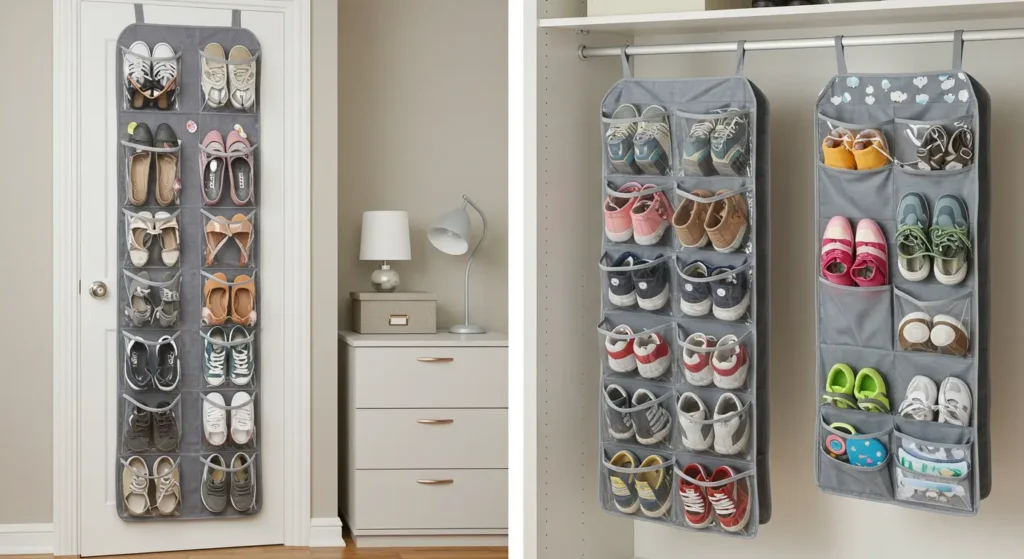
Maximize Space with Hanging Shoe Organizers
Hanging organizers are a smart, space-saving shoe storage solution—ideal for small spaces or closets low on floor room. By utilizing vertical space, they keep your footwear neatly displayed, easily accessible, and off the ground.
Top Hanging Storage Options
- Over-the-Door Organizers: With clear or mesh pockets, these are perfect for storing flats, sandals, or kids’ shoes. They’re versatile enough to hold socks, accessories, or shoe care items too.
- Closet Hanging Racks: These fabric or canvas racks hang from closet rods and often feature customizable compartments, fitting everything from sneakers to heels.
Why They’re Effective
Hanging shoe organizers help reduce clutter while keeping your collection visible and organized. They’re lightweight, affordable, and often come in neutral or stylish designs to match any decor.
6. Create Zones in Your Closet
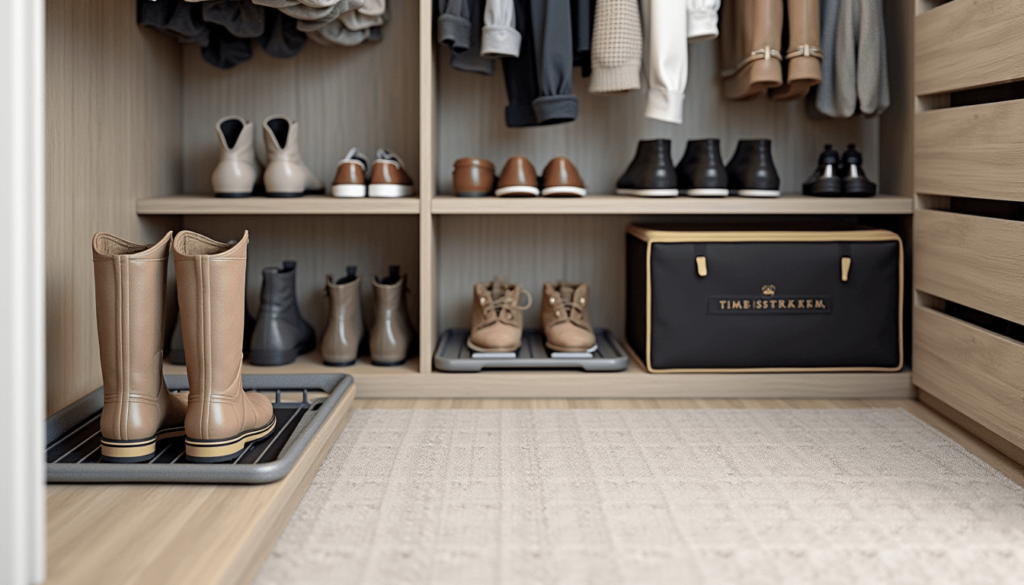
Create Closet Zones for Smarter Shoe Organization
Designating zones in your closet is a practical way to keep your shoe collection organized, accessible, and easy to navigate. By grouping shoes based on usage and seasonality, you’ll streamline your routine and make better use of your storage space.
Daily Use Zone
Keep your go-to shoes—like sneakers, flats, or office staples—at eye level or within easy reach. Use open shelves, pull-out drawers, or cubbies to keep them visible, neatly arranged, and scuff-free.
Occasional Use Zone
Store special-occasion shoes, seasonal footwear, or bulkier boots in higher or harder-to-reach spots. Top shelves, under-bed bins, or the back of your closet are ideal. Clear bins or labeled boxes make them easy to identify while keeping them dust-free.
7. Optimize Floor Space
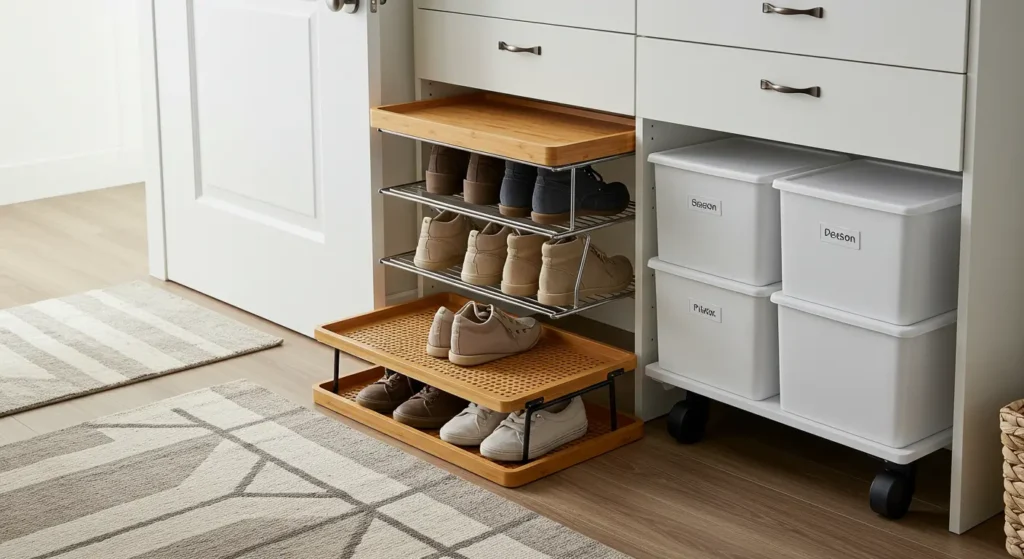
The floor of your closet or entryway is often an underutilized area that holds great potential for shoe storage. By strategically organizing this space, you can keep your shoes tidy, accessible, and protected from dirt or damage. Here are some effective ways to optimize your floor space:
Optimize Floor Space with Smart Shoe Storage Solutions
Strategically using your floor space can transform cluttered areas into efficient, tidy zones for shoe storage. With the right tools, you can keep your footwear clean, accessible, and out of the way.
Use Shoe Trays to Contain Mess
Waterproof trays with raised edges are perfect for wet or muddy shoes, especially near entryways. For visible areas, opt for stylish materials like bamboo or decorative metal that complement your home decor.
Rolling Bins for Off-Season Shoes
Low-profile rolling bins slide neatly under beds or shelves, making them ideal for storing seasonal or rarely worn shoes. Choose lidded or zippered bins to keep dust out and label them by category for easy retrieval.
In Conclusion, A well-thought-out shoe organization system does more than save space—it makes your daily routine smoother and your home tidier. By incorporating smart shoe storage ideas like vertical racks, stackable bins, and under-bed containers, you can keep your collection organized, protected, and easy to access.
Purpose-driven solutions not only help reduce clutter but also extend the life of your footwear. With a few creative tweaks, even the smallest spaces can be transformed into functional, stylish shoe storage zones that blend form and function effortlessly.

